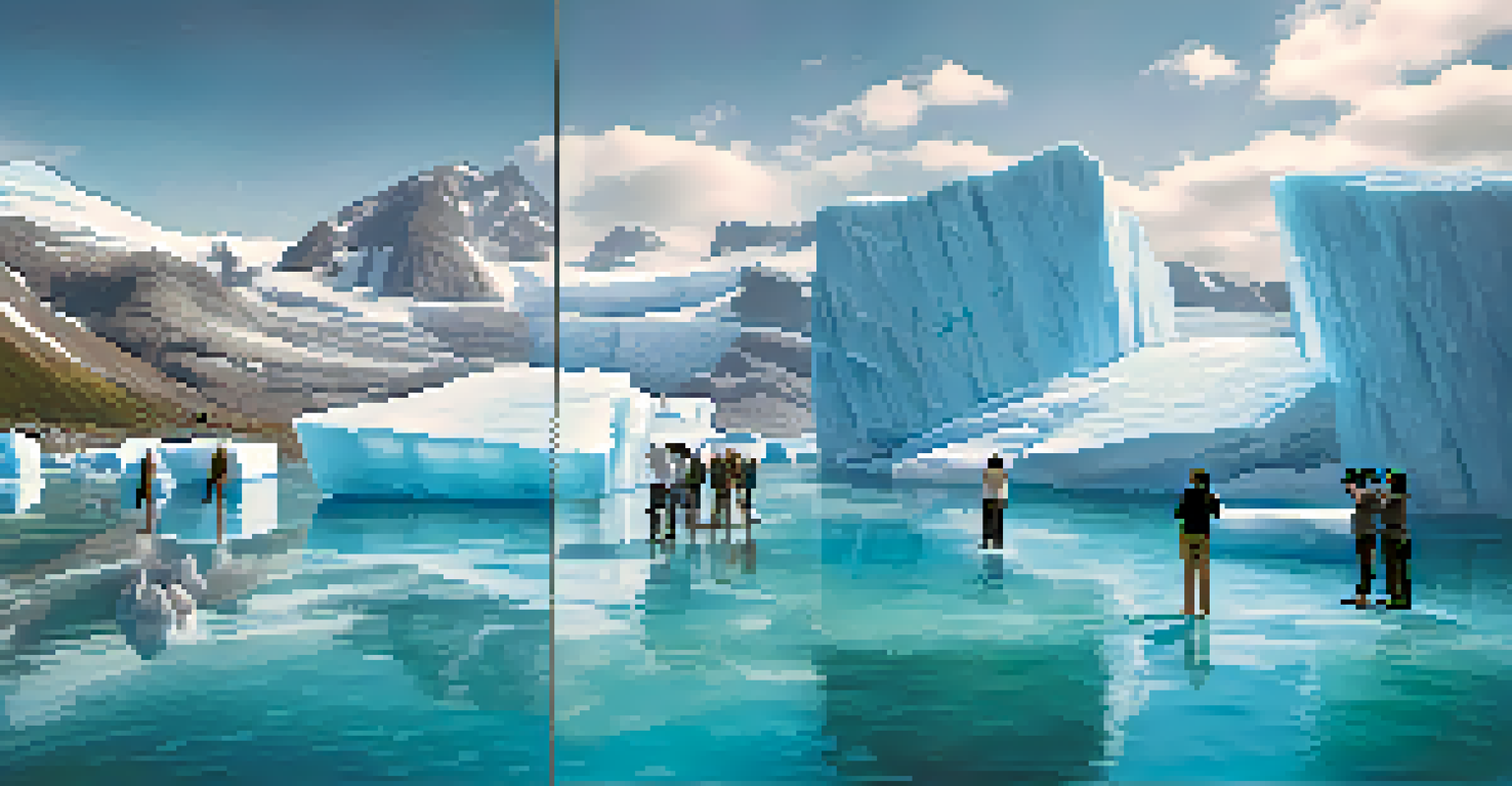The Role of Art in Shaping Climate Change Narratives

Art as a Catalyst for Climate Awareness
Art has the unique ability to evoke emotions and provoke thought, making it a powerful tool in raising awareness about climate change. Through various forms, such as paintings, sculptures, and installations, artists can convey complex environmental issues in a way that is relatable and accessible. For instance, a striking visual of a melting glacier can immediately highlight the urgency of global warming, prompting viewers to reflect on their own impact on the planet.
Art is not a mirror to reflect the world, but a hammer with which to shape it.
Moreover, art can capture the beauty of nature, reminding us of what is at stake if we fail to act. This emotional connection can inspire individuals to engage with climate activism, as they begin to see the environment not just as a backdrop, but as a vital part of their lives. By transforming abstract concepts into tangible experiences, art can galvanize communities around a shared cause.
As we navigate an increasingly digital world, art also plays a crucial role in online climate narratives. Social media platforms are filled with visual content that spreads awareness and ignites conversations about sustainability. When art meets technology, it creates a potent mix that can reach a global audience, amplifying the message of climate urgency like never before.
Storytelling Through Art: Connecting Cultures
Art serves as a universal language, bridging cultural divides and uniting people in the face of climate challenges. Through storytelling, artists can share their personal experiences and the struggles faced by their communities due to environmental degradation. This cultural exchange fosters empathy and understanding, encouraging collective action across diverse groups.

For example, indigenous artists often depict their ancestral lands and the threats posed by climate change, bringing attention to issues that might otherwise go unnoticed. These narratives not only highlight the impact of environmental shifts on specific communities but also advocate for their rights and the preservation of their heritage. Such stories resonate deeply with audiences, making the urgency of climate action more relatable.
Art Evokes Climate Awareness
Art serves as a powerful medium to highlight climate issues, inspiring individuals to reflect on their impact and engage in activism.
Additionally, collaborative art projects can bring together different communities to create shared narratives about climate change. By working together, artists and activists can amplify their voices, proving that collective efforts can lead to significant change. This sense of solidarity is essential in tackling the global climate crisis, as it reminds us that we're all in this together.
The Impact of Public Art Installations
Public art installations have the power to transform spaces and spark conversations about climate change. When art is placed in public areas, it becomes part of the community's daily experience, prompting individuals to engage with the subject matter in meaningful ways. For instance, a massive mural depicting endangered species can serve as a constant reminder of the biodiversity at risk.
The role of the artist is to make the revolution irresistible.
Moreover, public art can create interactive experiences that encourage community participation. Installations that involve audience interaction, such as the planting of trees or the creation of eco-friendly sculptures, invite people to take action themselves. This hands-on approach not only educates individuals about sustainability practices but also fosters a sense of ownership over the environmental issues affecting their communities.
As cities embrace public art movements, the potential for these installations to influence climate narratives grows. When citizens see their environment as a canvas for expression, it inspires a dialogue about the importance of protecting our planet. Public art thus becomes more than just decoration; it is a call to action for a sustainable future.
Film and Documentary: Visualizing Climate Change
Film and documentary have long been recognized as powerful mediums for storytelling, and when it comes to climate change, they play a crucial role in shaping public perception. Through compelling narratives and stunning visuals, filmmakers can capture the realities of climate-related disasters, making the abstract feel immediate and urgent. A well-crafted documentary can leave viewers with a deep understanding of the complexities surrounding climate issues.
For example, films like 'Chasing Ice' not only showcase the beauty of our planet but also document the alarming effects of climate change on glacial landscapes. By blending stunning cinematography with personal stories, these documentaries engage audiences on an emotional level, motivating them to become advocates for climate action. Viewers are often left with a sense of responsibility and a desire to contribute to solutions.
Storytelling Bridges Cultures
Through storytelling, art connects diverse communities, fostering empathy and collective action against climate challenges.
Moreover, film festivals dedicated to environmental themes create a platform for diverse voices and perspectives. They allow filmmakers and activists to share their work and reach wider audiences, amplifying discussions about sustainability. As more people engage with these narratives, a cultural shift can occur, leading to greater awareness and proactive behavior regarding climate change.
The Role of Music in Climate Activism
Music has an incredible ability to inspire and mobilize people, making it an essential component of climate activism. Songs that address environmental issues resonate with listeners, creating a sense of community and shared purpose. Through lyrics that speak to the urgency of climate action, musicians can encourage fans to get involved and make a difference.
For instance, artists like Billie Eilish and Jack Johnson have used their platforms to advocate for sustainability, often incorporating themes of environmentalism into their music. Concerts and festivals can also serve as venues for raising awareness, where artists perform for causes they believe in, further amplifying the message. This fusion of art and activism creates a vibrant culture of support for climate initiatives.
Additionally, music can enhance the emotional impact of climate-themed events and campaigns. Soundtracks at rallies or campaigns can evoke feelings of hope and determination, uniting people in their fight for a sustainable future. The rhythmic nature of music often leads to collective action, as anthems inspire movements that demand change on a larger scale.
Digital Art and Climate Change Narratives
In today's digital age, art has expanded beyond traditional mediums to include digital formats, which play a vital role in climate change narratives. Digital art allows artists to experiment with innovative techniques, creating immersive experiences that engage viewers in unique ways. For example, virtual reality experiences can transport individuals to affected landscapes, providing a firsthand glimpse of climate change's impact.
Moreover, social media has become a powerful platform for artists to share their work and raise awareness about environmental issues. Through viral campaigns, artists can reach millions, encouraging discussions and inspiring action. The dynamic nature of digital art fosters creativity and collaboration, enabling artists from around the world to contribute to the climate conversation.
Public Art Sparks Conversations
Public art installations transform spaces and encourage community participation, making climate change a part of everyday dialogue.
Digital art can also serve as a tool for education, making complex climate science more accessible. Infographics, animated videos, and interactive web experiences can break down intricate topics, helping audiences understand the urgency of the climate crisis. This accessibility encourages individuals to engage with the content and consider their role in creating a sustainable future.
The Future of Art in Climate Change Advocacy
As we look to the future, the role of art in climate change advocacy will only grow in importance. With the increasing urgency of environmental issues, artists will continue to innovate and find new ways to communicate their messages. By challenging conventions and pushing boundaries, art can inspire change and motivate action on a global scale.
Furthermore, collaboration between artists, scientists, and activists will become essential in driving impactful narratives. By combining expertise from different fields, these partnerships can create compelling projects that resonate with diverse audiences. This interdisciplinary approach can lead to more effective climate communication strategies that engage people from all walks of life.

Ultimately, the future of art in climate change advocacy hinges on its ability to connect with individuals on a personal level. By fostering empathy and understanding, art can inspire a collective movement toward sustainability, reminding us that we all have a role to play in protecting our planet. The hope is that through creativity, we can build a more sustainable future for generations to come.